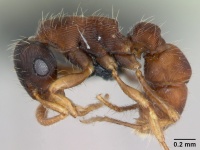Gnamptogenys bruchi
| Gnamptogenys bruchi | |
|---|---|

| |
| Scientific classification | |
| Kingdom: | Animalia |
| Phylum: | Arthropoda |
| Class: | Insecta |
| Order: | Hymenoptera |
| Family: | Formicidae |
| Subfamily: | Ectatomminae |
| Tribe: | Ectatommini |
| Genus: | Gnamptogenys |
| Species: | G. bruchi |
| Binomial name | |
| Gnamptogenys bruchi (Santschi, 1922) | |
Apparently a predator of Trachymyrmex and other leaf cutting ants (Kempf and Brown, 1968:92).
Identification
A member of the hartmoni complex (in the regularis subgroup of the mordax species group). Striate body sculpture with weak transverse impressions; metacoxal process is shaped as a low, triangular lobe; clypeal lamella broadly convex anterad. Kempf (1969) notes Gnamptogenys bruchi as close to Gnamptogenys hartmani and that a synonymy could be possible. He also mentions the variability of the extent of impression of the metanotal groove and discards it as an indicator of species separation. This could very well be only a variant of hartmani but due to differences of sculpture on the posterior petiole face, postpetiolar sternal process and c1ypeal lamella, I have chosen to conserve this name until more material can be studied. The sculpture on the dorsum of the petiole can vary from longitudinal to whorled. (Lattke 1995)
Keys including this Species
Distribution
Latitudinal Distribution Pattern
Latitudinal Range: 2.81972° to -31.657°.
| North Temperate |
North Subtropical |
Tropical | South Subtropical |
South Temperate |
- Source: AntMaps
Distribution based on Regional Taxon Lists
Neotropical Region: Argentina (type locality), Brazil, Paraguay.
Distribution based on AntMaps
Distribution based on AntWeb specimens
Check data from AntWeb
Countries Occupied
| Number of countries occupied by this species based on AntWiki Regional Taxon Lists. In general, fewer countries occupied indicates a narrower range, while more countries indicates a more widespread species. |

|
Estimated Abundance
| Relative abundance based on number of AntMaps records per species (this species within the purple bar). Fewer records (to the left) indicates a less abundant/encountered species while more records (to the right) indicates more abundant/encountered species. |

|
Biology
Castes
Nomenclature
The following information is derived from Barry Bolton's Online Catalogue of the Ants of the World.
- bruchi. Ectatomma (Parectatomma) bruchi Santschi, 1922d: 241 (w.) ARGENTINA (Córdoba).
- Type-material: syntype workers (number not stated).
- Type-locality: Argentina: Córdoba, Alta Gracia (C. Bruch).
- Type-depository: NHMB.
- Combination in E. (Commateta): Santschi, 1929h: 476;
- combination in Gnamptogenys: Brown, 1958g: 227; Camacho, Franco, Branstetter, et al. 2022: 11.
- Status as species: Santschi, 1929h: 476; Brown, 1958g: 227; Kempf, 1969: 275; Kusnezov, 1969: 35 (in key); Kempf, 1972a: 112; Bolton, 1995b: 208; Lattke, 1995: 162; Wild, 2007b: 27; Lattke, et al. 2007: 262 (in key); Feitosa, 2015c: 98; Camacho, et al. 2020: 460 (in key); Camacho, Franco, Branstetter, et al. 2022: 11.
- Distribution: Argentina, Brazil, Paraguay.
Description
References
- Brown, W. L., Jr. 1958g. Contributions toward a reclassification of the Formicidae. II. Tribe Ectatommini (Hymenoptera). Bulletin of the Museum of Comparative Zoology 118: 173-362 (page 227, Combination in Gnamptogenys)
- Camargo, K.S. de. 2011. Composicao e diversidade de "Poneromorfas" (Hymenoptera, Formicidae) em duas fitofisionomias de cerrado e padroes de distribuicao de "Poneromorfas", Pseudomyrmecinae e Cephalotini (Myrmicinae) para o Brasil. Thesis, Universidade de Brasilia.
- Lattke, J. E. 1995. Revision of the ant genus Gnamptogenys in the New World (Hymenoptera: Formicidae). J. Hym. Res. 4: 137-193. (page 160, figs. 43, 44 worker, male described)
- Lattke, J.E., Fernández, F. & Palacio, E.E. 2007. Identification of the species of Gnamptogenys Roger in the Americas (pp. 254-270). In Snelling, R.R., Fisher, B.L. & Ward, P.S. (eds). Advances in ant systematics: homage to E.O. Wilson – 50 years of contributions. Memoirs of the American Entomological Institute 80: 690 pp. PDF
- Kempf, W. W.; Brown, W. L., Jr. 1968. Report on some Neotropical ant studies. Pap. Avulsos Zool. (Sao Paulo) 22: 89-102. PDF
- Santschi, F. 1922e. Description de nouvelles fourmis de l'Argentine et pays limitrophes. An. Soc. Cient. Argent. 94: 241-262 (page 241, worker described)
- Santschi, F. 1929h. Révision du genre Holcoponera Mayr. Zool. Anz. 82: 437-477 (page 476, Combination in E. (Commateta))
- Ulysséa, M.A., Brandão, C.R.F. 2013. Ant species (Hymenoptera, Formicidae) from the seasonally dry tropical forest of northeastern Brazil: a compilation from field surveys in Bahia and literature records. Revista Brasileira de Entomologia 57, 217–224 (doi:10.1590/s0085-56262013005000002).
References based on Global Ant Biodiversity Informatics
- Kempf W. W. 1969. Miscellaneous studies on Neotropical ants. V. (Hymenoptera, Formicidae). Studia Entomologica 12: 273-296.
- Kempf W. W. 1978. A preliminary zoogeographical analysis of a regional ant fauna in Latin America. 114. Studia Entomologica 20: 43-62.
- Kempf, W.W. 1972. Catalago abreviado das formigas da regiao Neotropical (Hym. Formicidae) Studia Entomologica 15(1-4).
- Lattke J. E. 1995. Revision of the ant genus Gnamptogenys in the New World (Hymenoptera: Formicidae). Journal of Hymenoptera Research 4: 137-193
- Osorio Rosado J. L, M. G. de Goncalves, W. Drose, E. J. Ely e Silva, R. F. Kruger, and A. Enimar Loeck. 2013. Effect of climatic variables and vine crops on the epigeic ant fauna (Hymenoptera: Formicidae) in the Campanha region, state of Rio Grande do Sul, Brazil. J Insect Conserv 17: 1113-1123.
- Wetterer J. K. 2014. Geographic distribution of Gnamptogenys hartmani (Hymenoptera, Formicidae), an agro-predator that attacks fungus-growing ants. Terrestrial Arthropod Reviews 7: 147157.
- Wild, A. L.. "A catalogue of the ants of Paraguay (Hymenoptera: Formicidae)." Zootaxa 1622 (2007): 1-55.

